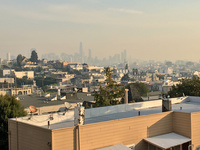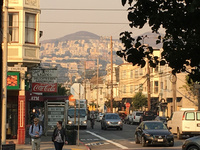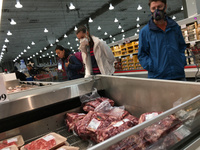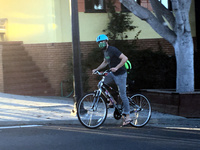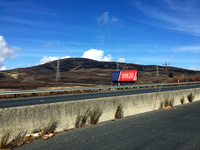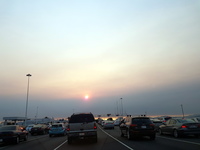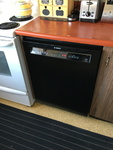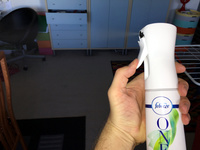 |
| Angelika/Mike Schilli |
|
|
|
Angelika Four weeks ago on Sunday, around half past eleven at night, it suddenly started smelling in our neighborhood as if everyone had lit their fireplaces at the same time. We really thought that either there was a fire in the neighborhood or one had broken out in our house. I'm constantly worried that our house might go up in flames, especially since a few guys in our apartment complex heavily consume alcohol and marijuana and aren't always fully aware. Also, sometimes rather strange figures lurk around on our roof. So, we always have to be on guard that nothing happens or no one gets the idea to start a bonfire there. On that particular Sunday, we first opened the balcony doors, but saw nothing. We only felt a warm strong wind blowing towards us, which was odd because the wind here is never warm. Michael then searched the internet to see if there was a fire anywhere in San Francisco. His research turned up nothing. Then he asked on the neighborhood forum "Nextdoor" if it smelled like smoke elsewhere, and in no time, despite the late hour, he received 70 responses: Not only did our neighborhood "Noe Valley" smell like an open fireplace, but all of San Francisco reeked of fire.
Soon it turned out that there were massive fires in the wine region of Napa, about an hour and a half drive away, and the surrounding areas of Sonoma, Calistoga, and Santa Rosa were ablaze. Fires in California in the autumn are unfortunately not uncommon, as months without rain leave the vegetation bone-dry, and just a small spark can quickly develop into a large wildfire, especially when driven by the wind. Later, the fires in Northern California this year turned out to be the worst in the state's history: over 40 people died and 8,889 buildings were destroyed, including many well-known wineries. Calistoga, which we visit every year for a long weekend (Rundbrief 04/2006), was also threatened by the flames but was saved at the last minute. The house of one of my colleagues, who lives in Santa Rosa, was consumed by flames. She was able to get herself and her four children to safety, but otherwise lost everything.
The air in San Francisco was as bad as in Beijing for days; the sunsets were beautiful but eerie. I have never seen such a bright red sun in my life. People were walking around everywhere with masks, though I'm not sure if that really helps. In the East Bay, where I often worked, I even had ash on my car.
We've had earthquake emergency kits under our bed for a long time (Rundbrief 09/2005), and an emergency rope ladder that we can use to rappel down in case it's no longer safe to use the stairwell. These kits naturally contain only practical items, and then we also have a fireproof safe with Michael's external hard drive and our will. We should probably also add our passports and Green Card, and my computer backups, so that my many photos, which I am so attached to, don't get lost. But what would we miss? What would be irreplaceable? What would we quickly gather if we only had minutes to leave the apartment?
Our answers might seem a bit cliché, but Michael would miss his collection of tools, and I would miss my jewelry. The reasons are similar: Michael has accumulated his tools over the years and even bought some at the traditional store Kustermann on Viktualienmarkt during a visit to Germany. For my jewelry, it's not about the relatively low material value, but about the sentimental value. I often buy jewelry when we are traveling, and Michael has given me many beautiful pieces for birthdays, anniversaries, and other special occasions. Good friends have also given me jewelry over the years. Thus, each piece of jewelry and each tool tells a story.
Experts familiar with disasters often advise not only to pack practical items in your emergency kits and backpacks but also to include a box of personal items that are irreplaceable. I find this to be an interesting exercise. What would you put in such a memory box?
The fires will have long-lasting effects on the entire Bay Area, particularly exacerbating the housing crisis. Even before the devastating fires, there was only a 1% vacancy rate for apartments and houses in Santa Rosa and the Napa wine region. However, at least 5% of the housing stock in Santa Rosa was destroyed by the fires. Even if homeowners decide to rebuild, the evacuees will need somewhere to live until their homes are ready. But this could take a while, as the owners of the burned houses must not only deal with their insurance companies but also ensure that the land is not contaminated with pollutants. The ash must be removed first.
Additionally, there is a shortage of construction workers. Those who are in a particularly difficult situation are the renters who lost their apartments in the fires, as they generally aren't among the high earners, and rents, which were already extremely high, are likely to increase further due to the housing shortage. Already, most people in the Bay Area spend 30-50% of their income on rent, with some even spending more. Although the California Penal Code Section 396 prohibits price gouging after disasters (prices cannot be increased by more than 10%), this doesn't help renters who have lost their affordable housing to the fires and now need to find something new in an overheated market. Many fear that this will lead to even more low-income earners leaving the Bay Area. The area is already experiencing shortages of teachers, cooks, dishwashers, and other service industry workers, who are essential to the community.
